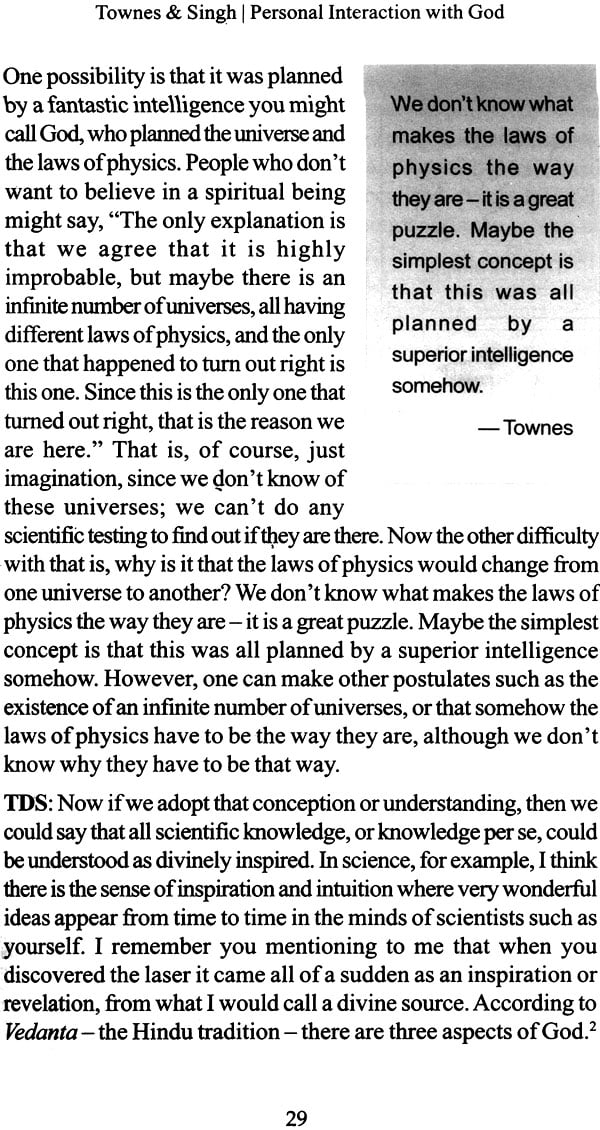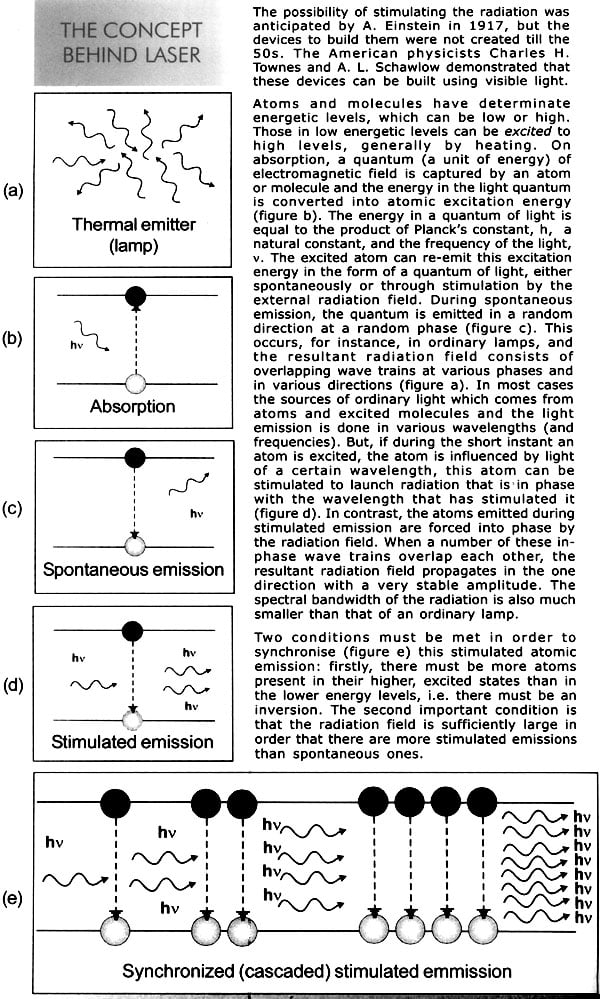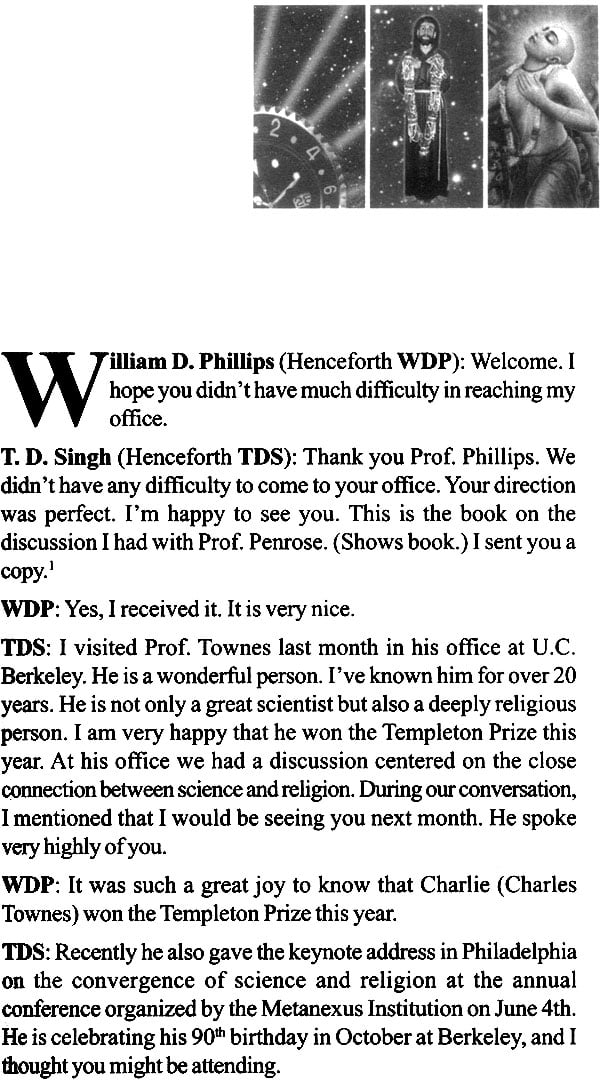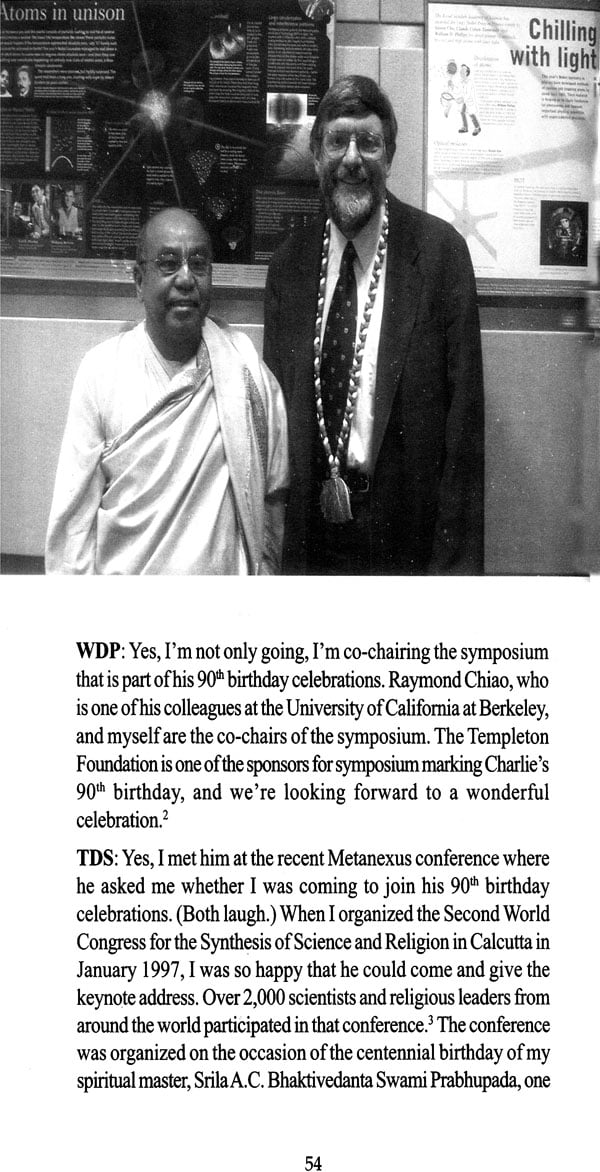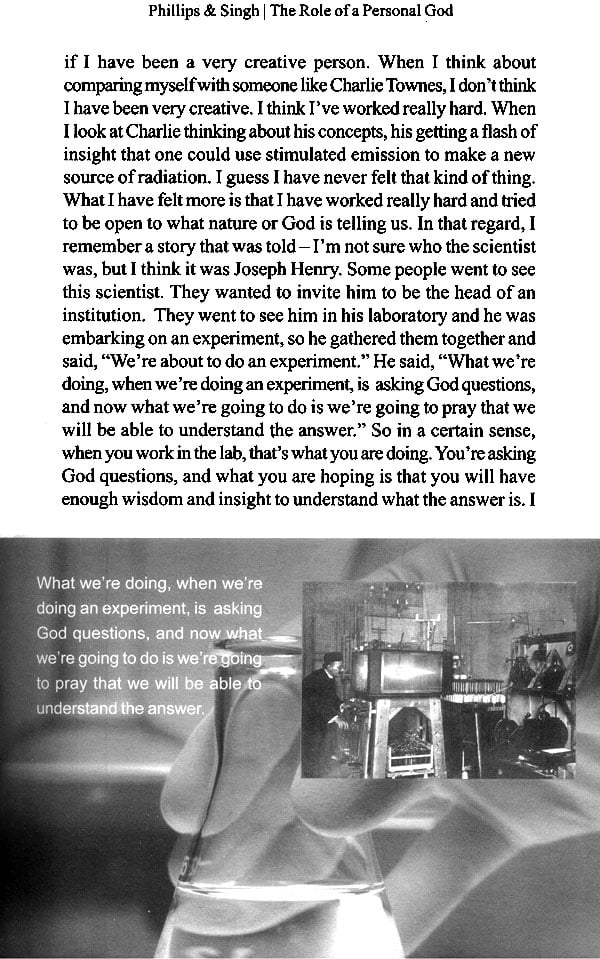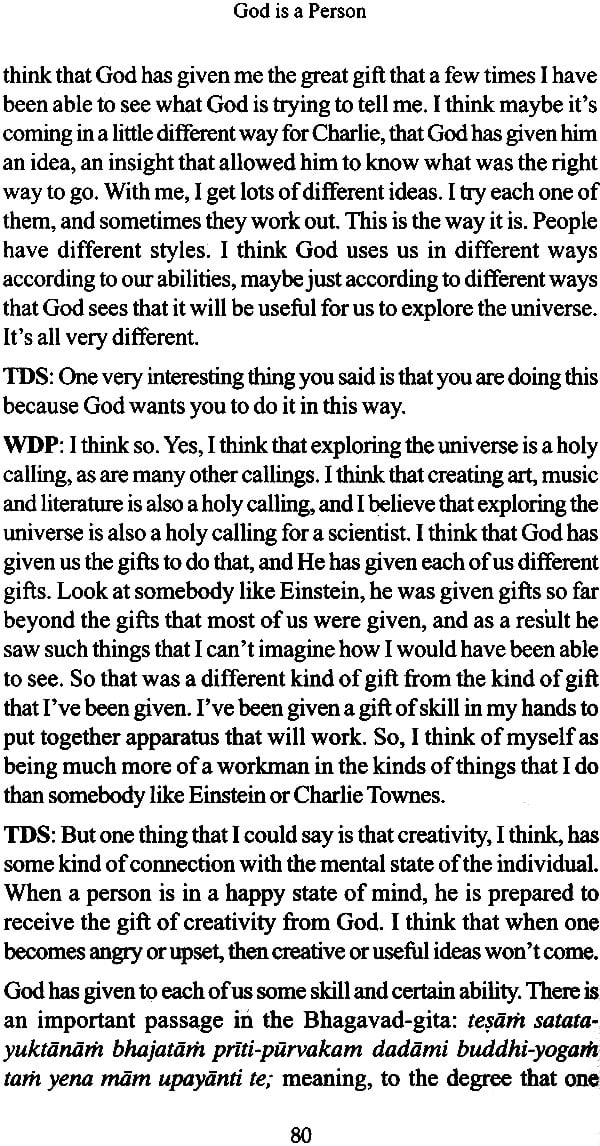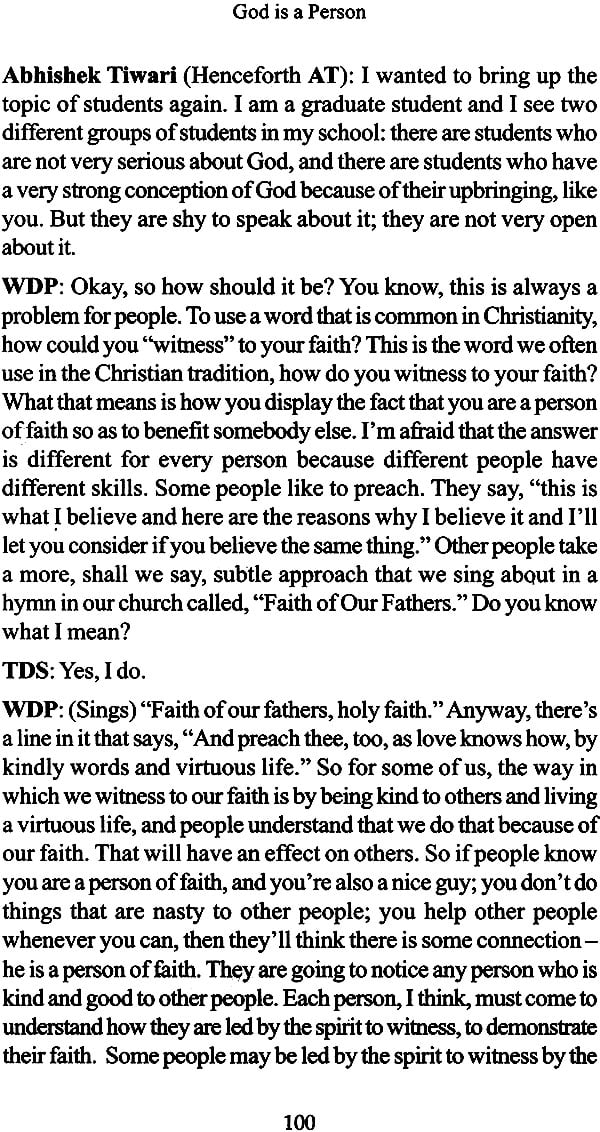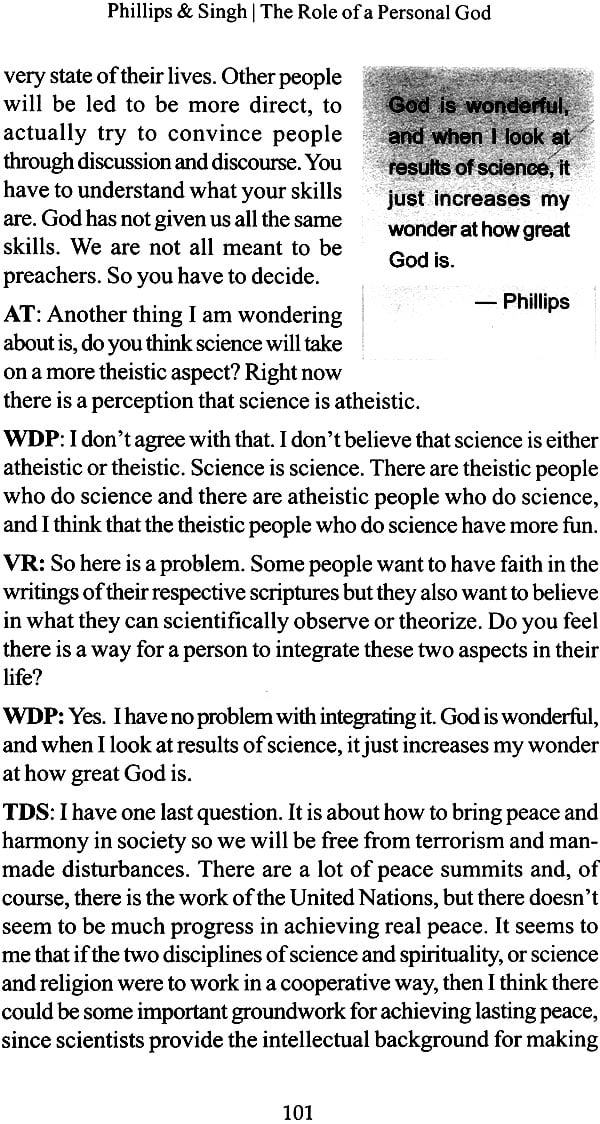
God Is A Person (Reflections of Two Nobel Laureates)
Book Specification
| Item Code: | NAG792 |
| Author: | Dr. T. D. Singh |
| Publisher: | Bhaktivedanta Institute, Kolkata |
| Language: | English |
| Edition: | 2010 |
| ISBN: | 9788189635039 |
| Pages: | 118 |
| Cover: | Paperback |
| Other Details | 8.5 inch X 5.0 inch |
| Weight | 170 gm |
Book Description
Are God and his personality mere imagination of the human mind? Or does He really exist with divine attributes? If He exists and has personality, what kind of person He is? Is He like us with physical bodies shaped by genome and acting in space-time? Or is He a transcendental personality beyond the comprehension of our tiny brains? This volume is an excellent presentation of two classic dialogues T. D. Singh had with two prominent Nobel Laureates in physics-Charles Townes and William Phillips. Charles Townes received the Nobel Prize in physics in 1964 for his discovery of laser and maser. He also won the Templeton Prize in 2005. His work on the laser opened the way to today's vast technological revolution and new frontiers of research in science. William Phillips received the 1997 Nobel Prize in Physics for using lasers to cool and trap neutral atoms which paved the way for scientists to design more precise atomic clocks and also to create the highly astonishing Bose-Einstein condensation T. D. Singh, who himself is a scientist with a Ph.D. from the University of California, Irvine, USA as well as a spiritualist in the in the Bhaktivedanta tradition of India, met both of them personally and had a significant exchange of ideas. He has been a pioneer in advancing science and religion dialogue from over three decades. The fine reflections of these remarkable thinkers of our times presented in this volume will help readers further shape their perceptions about the nature of the Ultimate Reality or God.
Dr. T. D. Singh (His Holiness Bhaktisvarupa Damodara Swami) (1937-2006): A scientist and spiritualist known for his pioneering efforts to interface between science and religion for a deeper understanding of life and the universe, he received his Ph. D. in Physical Organic Chemistry from the University of California, Irvine in 1974. He has contributed many papers in the Journal of American Chemical Society and the Journal of Organic Chemistry in the field of fast proton transfer kinetics in model biological systems using stopped-flow technique and NMR spectroscopy. He also worked on gas phase reaction mechanisms using Ion Cyclotron Resonance (ICR) spectroscopy. He underwent Vaishnava Vedanta Studies (1970-77) under His Divine Grace Srila Prabhupada and he was appointed by Srila Prabhupada as Director of the Bhaktivedanta Institute (1974-), which is a center to promote studies about the relationship between science and Vedanta. He has organized four International conferences on science and religion-First and Second World Congress for the Synthesis of Science and religion (Bombay, 1986 & Calcutta, 1997), First International Conference on the Study of Consciousness within Science (San Francisco, 1990) and Second International Congress on Life and Its Origin - Exploration from Science and Spiritual Traditions (Rome, 2004), where a galaxy of prominent scientists and religious leaders including several Nobel Laureates participated. He has authored and edited several books including What is Matter and What is Life? (1977), Theobiology (1979), Vedanta & Science Series: Life and Origin of the Universe (2004), Life and Spiritual Evolution (2005), and Essays on Science and Religion (2005), (Ed.) Synthesis of Science and Religion: Critical Essays and Dialogues (1987), Thoughts on Synthesis of Science and Religion (2001), Seven Nobel Laureates on Science and Spirituality (2004), Science, Spirituality and the Nature of Reality (2005), and Towards a Culture of Harmony and Peace (2005). He is the Editor-in-Chief of the Journal of the Bhaktivedanta Institute entitled, Savijnanam: Scientific Exploration for a Spiritual Paradigm.
Dr. Singh is also the Founder President of Vedanta and Science Educational Research Foundation, Kolkata and a founding member of the United Religions Initiative (URI). He is the Founder President of URI's Manipur (North-Eastern India) Cooperation Circle. As an educator, he established a network of schools in North-Eastern India and supervised and guided over 4000 students at these different schools. He is also an accomplished singer, instrumentalist, and poet. He founded "Ranganiketan Manipuri Cultural Arts Troupe" which has approximately 600 performances at over 300 venues in about 20 countries. He started building the University of Bhagavata Culture in Imphal, Manipur, India which will promote the universal Scientific and philosophical relevance of the teachings of Bhagavadgita, Srimad Bhagavatam, Vedanta and other Vedic literatures within the framework of modern cultural and educational milieu for the welfare of humanity.
The nature of the human soul is to explore the underlying secrets of the visible as well as the invisible worlds, to investigate the unknown and finally to inquire about the nature of the Ultimate Reality or God. The mind, the senses and the intelligence are instruments in this dynamic and most worthwhile exercise. Scientific knowledge is born out of such inquiry. Religious knowledge or spiritual wisdom is also aimed at finding and realizing the same Ultimate Reality.
According to the Vedanta, there are four defects of the senses. They are: (i) Bhrama (illusion), for example, a mirage seen in the desert; (ii) Pramada (mistake), for example, a rope maybe mistaken for a snake; (iii) Karanapatava (limitation), for example, we cannot hear sounds below 20 Hz (infrasonic) and above 20,000 Hz (ultrasonic); and (iv) Vipralipsa (cheat), for example, when the senses are overcome by pride, false ego, lusty desire and arrogance, one's propensity to cheat becomes predominant. Thus scientific knowledge, which is gathered by sense perception is very limited and we can grasp only a small fraction of reality. Scientific knowledge, therefore, cannot prove the existence of God. In other words, aroha-pantha, or the bottom- up approach is not sufficient to gain substantial knowledge of God. The timeless message of the Vedas proclaim that God can be understood through revealed knowledge, scriptures. Vedanta describes sastrayonitvat scriptures can give knowledge of God. This is called the avaroha-pantha, the top-down or parampara process.
The ancient Vedic scripture known as Srimad-Bhagavatam or Bhagavata Purana, the most ripened fruit of the Vedic tree of know ledge describes the three aspects of God realization as follows:
vadanti tat tattva-vidas
tattvam yaj jnanam advayam
brahmeti paramatmeti
bhagavan iti sabdyate
Brahman or the impersonal aspect of God realization is achieved by the students of the Upanishads, the philosophical literatures of the Vedas. It is an incomplete realization of God. Similarly, many scientists such as Einstein could grasp the impersonal aspect of God to some degree by their own experience of scientific investigation. Einstein was greatly impressed by observing the order and beauty of the laws of nature, grandeur and the mystical aspects of the universe. He remarked, "I believe in mystery and, frankly, I sometimes face this mystery with great fear. In other words, I think there are many things in the universe that we cannot perceive or penetrate and that also we experience some of the most beautiful things in life in only a very primitive form. Only in relation to these mysteries do I consider myself to be a religious man. But I sense these things deeply ... the most beautiful and most profound religious emotion that we can experience is the sensation of the mystical. And this mysticality is the power of all true science ... In essence, my religion consists of a humble admiration for this illimitable superior spirit that reveals itself in the slight details that we are able to perceive with our frail and feeble minds. That deeply emotional conviction of the presence of a superior reasoning power which is revealed in the comprehensible universe forms my idea of God.
Paramatma realization is achieved by the yogis. Paramatma is an indwelling partial expansion of the personality aspect of God, localized in all living entities primarily for guiding them in every aspect. It is the Paramatma from within that guides, inspires and gives creativity to the individual in scientific discoveries, musical composition and fine artistic works. However, according to Vedic scriptures, the Brahman and the Paramatma realization is a partial understanding of God.
Realization of Bhagavan is the realization of the supreme personality aspect of God and this is realized by sincere devotees and servants of God. According to the Vedas, this is the highest aspect of God realization.
According to Vedanta, God has three kinds of internal potency or energy, namely, the (i) Sandhini-sakti, or existential potency, (ii) Samvit-sakti, or cognitive potency and the (iii) Hlddini-sakti or pleasure potency. This is also confirmed in the Visnu Purana (1.12.69). In the Bhagavata-sandarbha (103), Srila Jiva Goswami explains these transcendental attributes of God elaborately (CC Adi 4.60). The living beings are also endowed with these attributes in different degrees.
| 1.PERCEIVING GOD | 8 |
| 2.INTRODUCTION | 18 |
| 3. IMPORTANCE OF SCIENCE-RELIGION DIALOGUE | 24 |
| AND PERSONAL INTERACTION WITH GOD | |
| 4. LASER COOLING OF ATOMS AND THE ROLE OF A PERSONAL GOD | 50 |
| ABOUT THE EDITOR | 108 |
| ABOUT BHAKTIVEDANTA INSTITUTE | 110 |
| BHAKTIVEDANTA INSTITUTE'S RECENT PUBLICATIONS | 112 |
